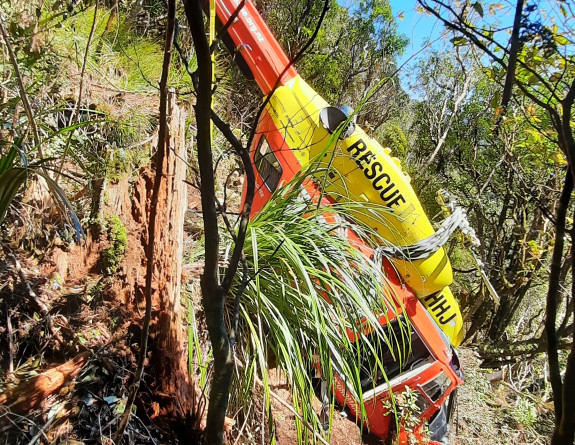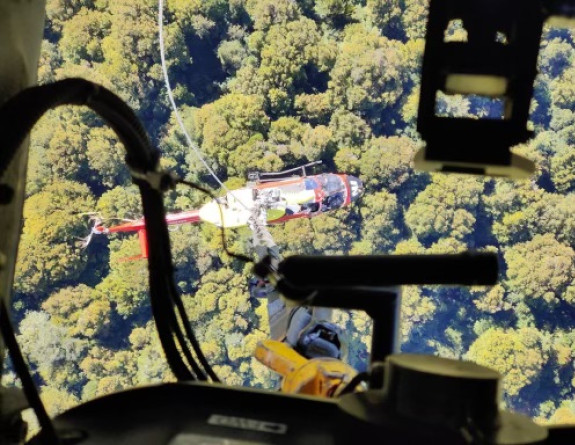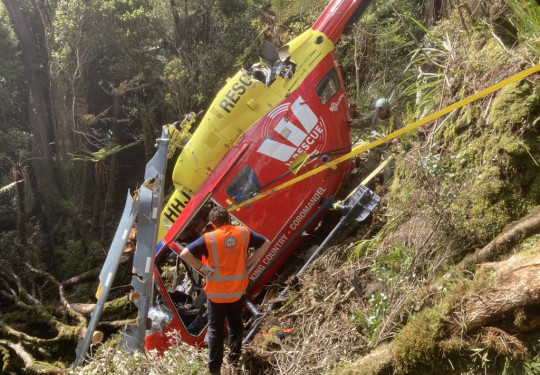Helicopter recovers helicopter
There’s no manual on using an Air Force helicopter to lift a crashed helicopter off a steep tree-covered mountain. No. 3 Squadron and NZ Army’s 5 Movements Company combined their expertise to get it done.
06 November, 2023
In September a Westpac rescue helicopter crashed in dense bush on Mt Pirongia in Waikato, while on a mission to rescue a tramper. The three crew walked away uninjured, but the aircraft suffered substantial damage. The Transport Accident Investigation Commission (TAIC) is investigating the incident.
There were a number of challenges facing crews working on how to recover the chopper, weighing more than two tonnes, even with the rotor blades and extra materials removed. It was resting on a 56° slope, surrounded by trees and bush, almost 3000ft high, NH90 pilot Flight Lieutenant (FLTLT) Hamish Park said.
“The higher you climb the less performance you have with the helicopter.”
The rigging experts, 5 Movements, were called in, along with TAIC and No. 3 Squadron, to work out how to safely attach the Westpac chopper to strops attached to an NH90.
“This isn’t something the Air Force or 5 Movements routinely does. I guess 5 Movements is used to rigging a net or a Pinzgauer in accordance with the manual, whereas there’s no approved military method of how to lift a chopper off a 56° slope,” FLTLT Park said.
“We identified a few key hazards, or things we needed to mitigate, to enable the flight. What became evident was just downhill from where the chopper crashed was a fairly large cliff. People at the site had to be careful of the cliff edge, likewise we didn’t want the helicopter to fall off the cliff.”
In the days before the lift, Department of Conservation staff cleared the site and 5 Movements secured the helicopter to nearby trees. They also helped removed the rotor blades and other non-essential items.
On the day itself, the NH90 pilots flew near to the site and winched down the movers, a TAIC investigator and some lifting equipment needed to rig up the chopper.
“When they were ready we flew in, lowered the strop to the ground. The movers rigged and hooked the helicopter on. We gently came up, took the slack out of the strop, which was still secured to the ground, the loadmasters gave a signal to cut the moorings. The movers then gave them the signal it was all released and at that point we lifted it up off the hill.”


No. 3 Squadron and NZ Army’s 5 Movements Company combined their expertise to lift a crashed helicopter off a steep tree-covered mountain.
The NH90 flew the stricken helicopter to a paddock, just minutes away and the pilots gently lowered it to the ground.
“It all went pretty much exactly to plan. But we still had more work to do – we flew back up and took another underslung load of the blades and equipment off the hill and dropped them off, then flew back up and winched all of the team out.
“Recovering the helicopter took about 15 minutes and then about an hour for the rest, but there was days of planning it out,” FLTLT Park said.
“I was stoked to be on the job, because it’s a really cool job to do. It was great to be able to help out the rescue team because they do a lot of good work.”
He paid tribute to the hard work of 5 Movements and also the Air Force refuellers who drove down from Auckland to support the aircrew.
“5 Movements did an awesome job. At times we work relatively closely with them because they are the authority on this stuff. They did some hard work on that hill over a couple of days.”
For Helicopter Loadmaster Sergeant Brilee Jordan, the mission was her first task as a new loadmaster.
“It was an exciting first task for me. It was interesting getting to work with the 5 Movements guys, in terms of all the load-rigging gear and how we were going to move the helicopter.
“Because pilots can’t see the load directly underneath the aircraft, we were providing the hand signals to the ground crews,” she said.
“We dropped the underslung gear out of the helicopter, flew it over to the hook-on party and they loaded the rigging to the underslung load gear and we took the weight. We were responsible for positioning the helicopter over the load when we took the weight of it.”
Crews were unsure how the Westpac chopper would fly under the NH90, but SGT Jordan said it was “weather-cocked” into the direction of travel and didn’t swing.
“It flew surprisingly well. We were concerned it was going to spin because that’s the concern when you’re flying unfamiliar loads. It wasn’t an everyday pick up. It was a really interesting challenge for everyone involved.”
